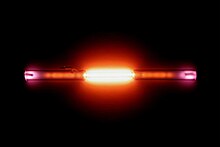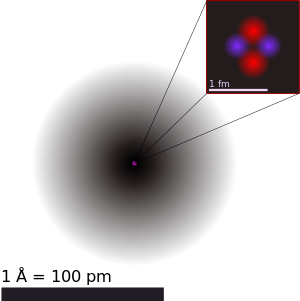
Back Helium-4 Afrikaans هيليوم-4 Arabic Heli 4 Catalan Helium-4 Czech Helio-4 Spanish Helio 4 Basque هلیوم-۴ Persian Hélium 4 French הליום-4 HE हिलियम-४ Hindi
This article needs additional citations for verification. (December 2023) |
 | |
| General | |
|---|---|
| Symbol | 4He |
| Names | helium-4, 4He, He-4 |
| Protons (Z) | 2 |
| Neutrons (N) | 2 |
| Nuclide data | |
| Natural abundance | 99.999863% |
| Half-life (t1/2) | stable |
| Isotope mass | 4.002603254 Da |
| Spin | 0 |
| Binding energy | 28295.7 keV |
| Isotopes of helium Complete table of nuclides | |

Helium-4 (4
He
) is a stable isotope of the element helium. It is by far the more abundant of the two naturally occurring isotopes of helium, making up about 99.99986% of the helium on Earth. Its nucleus is identical to an alpha particle, and consists of two protons and two neutrons.
Helium-4 makes up about one quarter of the ordinary matter in the universe by mass, with almost all of the rest being hydrogen. While nuclear fusion in stars also produces helium-4, most of the helium-4 in the Sun and in the universe is thought to have been produced during the Big Bang, known as "primordial helium". However, primordial helium-4 is largely absent from the Earth, having escaped during the high-temperature phase of Earth's formation. On Earth, most naturally occurring helium-4 is produced by the alpha decay of heavy elements in the Earth's crust, after the planet cooled and solidified.
When liquid helium-4 is cooled to below 2.17 K (−270.98 °C), it becomes a superfluid, with properties very different from those of an ordinary liquid. For example, if superfluid helium-4 is placed in an open vessel, a thin Rollin film will climb the sides of the vessel, causing the liquid to escape. The total spin of the helium-4 nucleus is an integer (zero), making it a boson. The superfluid behavior is a manifestation of Bose–Einstein condensation, which occurs only in collections of bosons.
It is theorized that at 0.2 K and 50 atm, solid helium-4 may be a superglass (an amorphous solid exhibiting superfluidity).[1][2][3]
- ^ Giulio Biroli; Claudio Chamon; Francesco Zamponi (2008). "Theory of the superglass phase". Physical Review B. 78 (22): 19. arXiv:0807.2458. Bibcode:2008PhRvB..78v4306B. doi:10.1103/PhysRevB.78.224306. S2CID 3222218.
- ^ "Press release: Supersolid or superglass? Cornell researchers study a strange state of matter in helium - Cornell Chronicle".
- ^ Yu, Xiaoquan; Mueller, Markus (2012). "Mean field theory of superglasses". Physical Review B. 85 (10): 104205. arXiv:1111.5956. Bibcode:2012PhRvB..85j4205Y. doi:10.1103/PhysRevB.85.104205. S2CID 119261743.